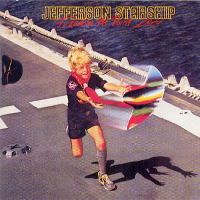From Wikipedia, the free encyclopedia
1979 studio album by Jefferson Starship
Freedom at Point Zero Jefferson Starship and was released in 1979. It was the first album for new lead singer Mickey Thomas , and the first after both Grace Slick and Marty Balin left the previous year (Slick rejoined the band for their next album Modern Times Aynsley Dunbar plays drums on this album; he had left Journey the previous year. The album cover was shot on location in the San Francisco Bay on board the USCGC Midgett .
The single "Jane " peaked on the Billboard Hot 100 Cash Box [ 3] Grand Theft Auto IV: The Lost and Damned Wet Hot American Summer Wet Hot American Summer: First Day of Camp Paul Kantner -led Jefferson Starship TNG and the Mickey Thomas -led Starship . The song "Lightning Rose" predicts the concept of the Nuclear Furniture Nuclear Furniture as the key character in that album's concept.
Track listing
Title Lyrics Music 1. "Jane " David Freiberg , Jim McPhersonFreiberg, McPherson, Paul Kantner , Craig Chaquico 4:07 2. "Lightning Rose (Carry the Fire)" Kantner Kantner 4:36 3. "Things to Come" Kantner, China Wing Kantner P. Kantner 4:49 4. "Awakening" Jeannette Sears Pete Sears 7:59 5. "Girl with the Hungry Eyes" Kantner Kantner 3:28 6. "Just the Same" Chaquico, J. Sears Chaquico, Eric Van Soest 5:17 7. "Rock Music" Chaquico, J. Sears Chaquico 3:35 8. "Fading Lady Light" J. Sears P. Sears, Mark Unobsky 3:39 9. "Freedom at Point Zero (Climbing Tiger Mountain through the Sky)" Kantner Kantner 4:25
Charts
Personnel
Mickey Thomas – lead (1, 3-9) and backing vocalsPaul Kantner – lead (2, 9) and backing vocals, rhythm guitar, keyboards (3)Craig Chaquico – lead guitar, rhythm guitarDavid Freiberg – bass (1, 2, 4, 6, 8) synthesizer (3, 5, 7, 9), backing vocalsPete Sears – bass (3, 4 (intro), 5, 7, 9), piano (1, 2, 4), electric piano (6), organ (8), rhythm guitar (8), backing vocalsAynsley Dunbar – drums, percussion
Additional personnel
Production
Ron Nevison – producer for Gadget Productions, Inc., engineerMichael Clink – engineerMike Reese – mastering
Pat Ieraci (Maurice) – production coordinator
Paul Dowell – amp consultant
Ria Lewerke-Shapiro – art direction, design
Gary Regester – photography
Tyrone Q. Thompson – star scout
Bill Thompson – manager
Recorded and mixed at The Record Plant , Los Angeles - Sausalito
Mastered at The Mastering Lab, Hollywood
Singles
References
Studio albums
Jefferson Airplane Jefferson Starship Starship
Live albums Archival releases Compilations Singles Related articles

